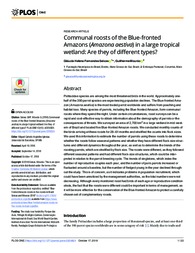Communal roosts of the Blue-fronted Amazons (Amazona aestiva) in a large tropical wetland: Are they of different types?
Communal roosts of the Blue-fronted Amazons (Amazona aestiva) in a large tropical wetland: Are they of different types?
Author(s): SEIXAS, G. H. F.; MOURAO, G. de M.
Summary: Psittacidae species are among the most threatened birds in the world. Approximately onehalf of the 390 parrot species are experiencing population declines. The Blue-fronted Amazon (Amazona aestiva) is the most traded parrot worldwide and suffers from poaching and habitat loss. Many species of parrots, including the Blue-fronted Amazon, form communal roosts where they spend the night. Under certain circumstances, roost surveys can be a rapid and cost-effective way to obtain information about the demography of parrots or the consequences of threats. We surveyed an area of 2,700 km2 in a large wetland in mid-western of Brazil and located five Blue-fronted Amazon roosts. We conducted monthly counts of the birds arriving at these roosts for 28±61 months and stratified the counts into flock sizes. We used this information to estimate the number of parrots using these roosts to determine whether the roosts follow seasonal patterns and whether they have different flock-size structures and different dynamics throughout the year, as well as to determine the trends of the roosting parrots, which are stratified by flock size. The roosts were different, as they followed different seasonal patterns and had different flock-size structures, which could be interpreted in relation to the parrot breeding cycle. The trends of singletons, which index the number of reproductive couples each year, and the number of pairs parrots increased or fluctuated around a baseline, but the number of fledged young in the year declined throughout the study. This is of concern, as it indicates problems in population recruitment, which could have been unnoticed by the management authorities, as the total numbers were not decreasing. Although every monitored roost had birds of each age or reproductive condition strata, the fact that the roosts were different could be important in terms of management, as it will be more effective for the conservation of the Blue-fronted Amazon to protect a carefully chosen set of complementary roosts.
Publication year: 2018
Types of publication: Journal article
Unit: Embrapa Pantanal
Keywords: Ave Selvagem, Papagaio, Parrots, Psittacidae
Related content
Observation
Some of Embrapa's publications are published as ePub files. To read them, use or download one of the following free software options to your computer or mobile device. Android: Google Play Books; IOS: iBooks; Windows and Linux: Calibre.
Access other publications
Access the Agricultural Research Database (BDPA) to consult Embrapa's full library collection and records.
Visit Embrapa Bookstore to purchase books and other publications sold by Embrapa.

